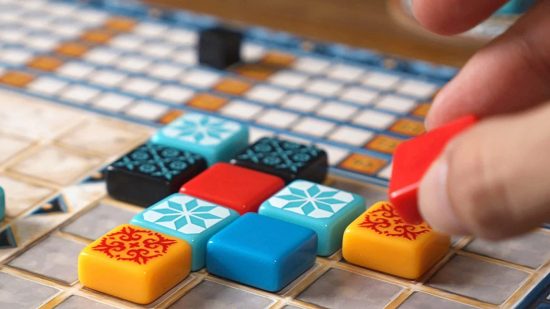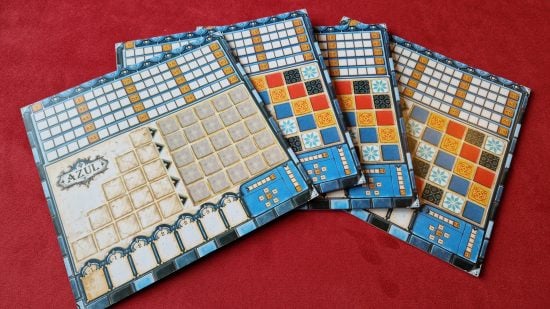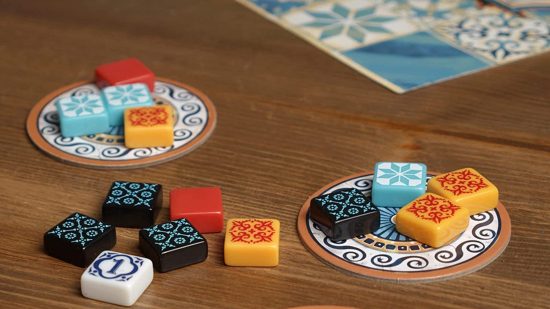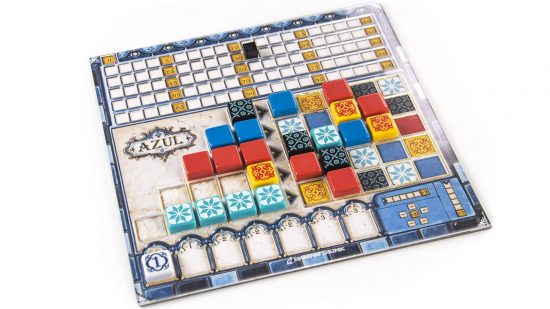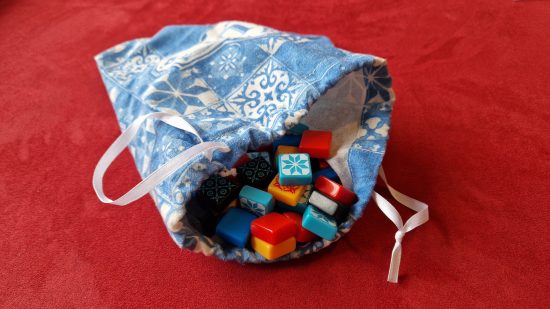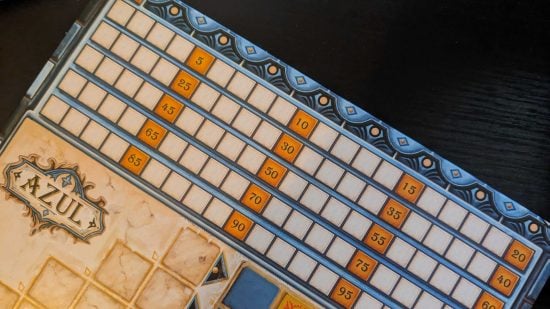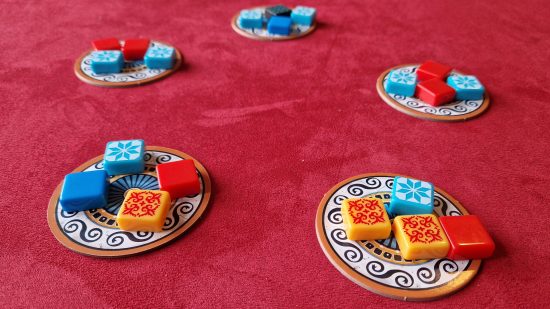It’s not too tricky to learn how to play Azul, and with a step-by-step tutorial, learning becomes even easier. We’ve spent hours pondering the beautiful mosaics of Azul, placing tiles in ways that both soothe and stir the strategic minds of board game fans everywhere. Below you’ll find a complete guide to the core Azul rules.
Before we begin teaching this tactile tile game, here are some of the other best board games worth checking out. Our guides recommend similar drafting games, as well as other gateway games that are super beginner-friendly. We can also give you a full Azul review if you’re still thinking about buying a copy.
Here’s how to play Azul:
Azul board game overview
Azul is an abstract strategy game for two to four players. During a game, players take turns openly drafting tiles and placing them on their player board to create mosaic patterns. There are multiple ways to score (or lose) points depending on the tiles you choose, so it helps to pick carefully!
A game of Azul is estimated to take between 30 and 45 minutes. It’s not too complex, so it’s suitable for board game fans aged eight and above.
Azul setup
First, give each player their own player board. These are double-sided and can be used for two types of game. If you’ve not played before, we recommend starting with a regular game, which means using the more colorful side of the player board. Every player must use the same side of the player boards for a game – there’s no mix and matching.
Everyone takes a scoring marker and places it on the ‘zero’ square at the top of their board’s score track. Next, place the circular factory display boards in the center of the table where everyone can reach them. The number you place depends on how many players there are:
- Two players – five factory displays
- Three players – seven factory displays
- Four players – nine factory displays
After this, you’ll need to fill the game’s cloth bag with 20 tiles of each color. Traditionally, the person who last visited Portugal goes first, and play continues clockwise. You might want to decide some other way if none of you have visited (or you just want to shake up player order between games).
The starting player fills each factory display board with four random tiles drawn from the bag. Now you’re ready to play.

Azul rules
Each round of Azul can be split into three phases. The official rules call these ‘Factory offer’, ‘Wall-tiling’, and ‘Preparing the next round’. We’ll also talk about the two stages of scoring, too.
Factory offer
This is the part where you draft your tiles. First, someone needs to place the starting player marker in the middle of the table (not on a factory display board). Then the starting player can make their first pick.
There are two ways to draft tiles in Azul. You could choose all tiles of the same color from a single factory display board. If you do so, the remaining tiles from that board are emptied into the center of the table, where the starting player marker was placed.
Alternatively, you could choose all tiles of the same color from the pile in the center of the table. The first player who does so in a round takes the first player token and adds it to the leftmost free space on their floor line. This is a row of squares at the bottom of each player board, and it’ll become important later when we get to scoring. For now, all you need to know is that having tiles in the floor line is a bad thing.
Next, it’s time to add your drafted tiles to your player board. These are added to one of the five pattern lines on the left half of the player board. Each of these can hold a different number of tiles – the top holds only one, while the bottom can contain five.
Place your drafted tiles in a single pattern line from right to left. You can add tiles to a pattern line that already contains tiles, but only if the newly-added tiles are of the same color. If you have more tiles of a color than space in the pattern line, the extra tiles must be added to the floor line from left to right.
Wall-tiling
When there are no more tiles on the factory display board or in the center of the table, the wall-tiling phase begins. Everyone can perform their own wall-tiling phase at the same time, but it can be helpful to take turns if you’re still learning the rules.
First, establish how many complete pattern lines you have (ones where every square has a tile in it). Then, from top to bottom, move the rightmost tile from your pattern line to a square that matches its color on the mosaic wall. The remaining tiles in the pattern line are returned to the game box.
Every time you place a tile on your wall, you score points for it straight away, so be sure to calculate this before moving onto the next pattern line.
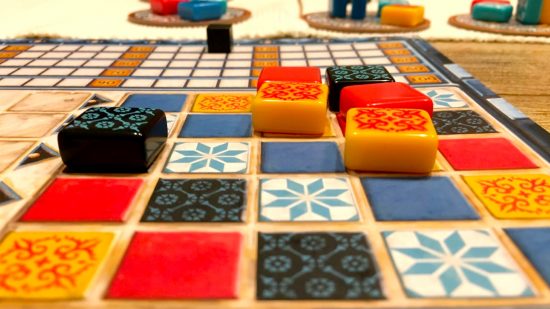
Azul scoring – during play
When scoring during the wall-tiling phase, each individual tile placed on your wall is worth one point. It’s worth extra points if you have other tiles linked to it, both horizontally and vertically.
For example, let’s say you place a tile that joins a line of two other horizontal tiles and three other vertical tiles. You score one point for the new tile and two for the linked horizontal tiles. Then you score your new tile again, gaining one point for placing it and three additional points for the linked vertical tiles. That gives you a sum of seven points.
At the end of the wall-tiling phase, you also subtract points for any squares that have been filled on the floor line. Each square on the floor line deducts an increasing number of points, starting at minus one and ending at minus three. Any tiles in the floor line are returned to the game box after scoring.
Preparing the next round
A game of Azul ends when one player has filled all five squares in a horizontal line on their wall. If this hasn’t happened yet, a new round begins after the wall-tiling phase.
The player with the starting player marker will now go first. They’ll need to refill each factory display board with four tiles from the bag and return the starting player tile to the center of the table.
If the bag is empty, add any tiles returned to the game box back in, and use these to finish filling the factory display boards. If there are no tiles in the game box, you’ll need to play without enough tiles for each factory display – but this is a pretty rare occurrence.
After the first round, you’ll need to be even more careful when drafting and placing tiles. If a pattern line is adjacent to a wall line that already has a tile of the color you’re trying to draft, you aren’t allowed to place your newly drafted tiles there. They’ll have to go in a pattern line that hasn’t already placed that color tile – or in the floor line (which should be avoided at all costs).
Azul scoring – end of the game
Once someone has filled five horizontal tiles on their wall in a wall-tiling phase, the game is over. Here additional points are calculated, and the person with the most points is declared the winner.
Any player who completed a horizontal line on their wall gains two points per completed line. Everyone who completed a vertical line of five tiles gains seven points per line. And finally, players gain ten points for each color tile where they’ve collected five of that same type.
Azul variant rules
When playing with the grey side of the player boards, the Azul rules are mostly the same. There is, however, a new rule when placing tiles on your wall.
When you add a tile to your wall from the pattern line, you can place it on any space in that line of the wall, regardless of color. While you can place your tiles anywhere in a wall line, no color can appear in a horizontal or vertical line more than once. If you can’t move a tile onto your wall in the wall-tiling phase, all tiles in that pattern line must be placed in the floor line.
Looking for more strategy board games to try? Here are the best board games for adults, as well as family board games for tabletop fans of a broader age range.

